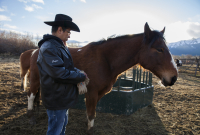Support strong Canadian climate journalism for 2025
The drumbeat grew louder for a national inquiry into a missing and murdered First Nations woman Monday night in Winnipeg, as family members sang and prayed in commemoration of their 15 year-old “beauty queen” whose body was discovered in the city's Red River one year ago.
Tina Fontaine’s body was pulled from the river in a plastic bag Aug. 17, 2014. Police believe her killer, still at large, left her in that state. It was about a week after she went missing from Child and Family Services' care.
“It feels like yesterday that she’s been gone,” said her cousin, Rose Fontaine, 16, from Sagkeeng First Nation.
The cousin poked over a now-weathered makeshift memorial site — with candles, sweet grass, and personal mementos —looking for the items she left to honour her cousin, including some nail polish. It was sticking out of the mud.
“She always had nice nails. She took care of them. She was a little beauty queen,” the teen said, wiping away tears.
“There’s things that are not there anymore, like a photo. I left a couple of things that I think got washed away when the docks flooded.”
Rose Fontaine said the two girls were close and enjoyed going for walks to town and dressing up. "She would run around the house in high heels and just have fun. She kept everyone happy. It’s really difficult because we shouldn’t have to be doing this. We shouldn’t be here today,” she said.

Tina Fontaine was discovered while police divers were looking for another missing person —Faron Hall, known to locals as Winnipeg's "homeless hero" for having saved a life in the river once before.
Faron's uncle, Patrick Hall, grieved Monday for both of them.
“To have found [Tina] that way through the death of my nephew —who knows how long she would’ve been still down there. But that’s why I came here today - to pray and sing. To offer water for the loss of those two lives,” said Hall.
“And when you think about this young girl’s life that was deliberately taken from her. That should never happen to a child,” he added, with sobs.
Hall puts the blame on the child welfare system.
"If they want to take away the children [from their parents], they should give them support right up until they fully understand and can cope with the world on their own —not just shuffle them out the door.”
“I think this where the system is failing our people. I was part of the sixties scoop,” he said.

Candace Volk [left, standing] among other attending to Tina Fontaine's memorial on the Red River in Winnipeg on Monday. Mychaylo Prystupa, National Observer.
Frustration over Tina Fontaine's death led to “Drag the Red” —a volunteer effort to scour the riverbanks for forensic evidence that might help police crack many of the city’s other unsolved murders of young Aboriginal people. Police are still investigating her death.
The killing came at a difficult time of turmoil for the teen. Her father was murdered just two years earlier. Gravestones were laid this weekend for both the father and daughter.
The media attention over Tina Fontaine's case prompted yet more calls for a national inquiry into missing and murdered First Nation women —something Prime Minister Stephen Harper has so far rejected.
“It should’ve happened a long time ago —maybe it would’ve prevented something like this,” said Hall.
Candace Volk doesn’t know the Fontaine family, but it hardly matters. She lost her niece to murder, and came out to support the family, and lay tobacco in the water.
“There’s lots of cases of missing and murdered women out there. My niece is Hillary Wilson, and it was on the 20th of this month, six years ago that she was found murdered. And still no answers. No one’s been charged with her murder,” said Volk.
“Tina and Hillary are just [two] of hundreds, hundreds. There’s no answers.”
“Our lives will never be normal again."





Comments